If you have the opportunity to travel to Hanoi, visit Tran Quoc Pagoda, a unique ancient pagoda located at 46 Thanh Nien, Yen Phu Ward, Tay Ho District. With an age of up to 1500 years, this is one of the oldest pagodas in Vietnam and was honored to be in the Top “10 most beautiful pagodas in the world”.
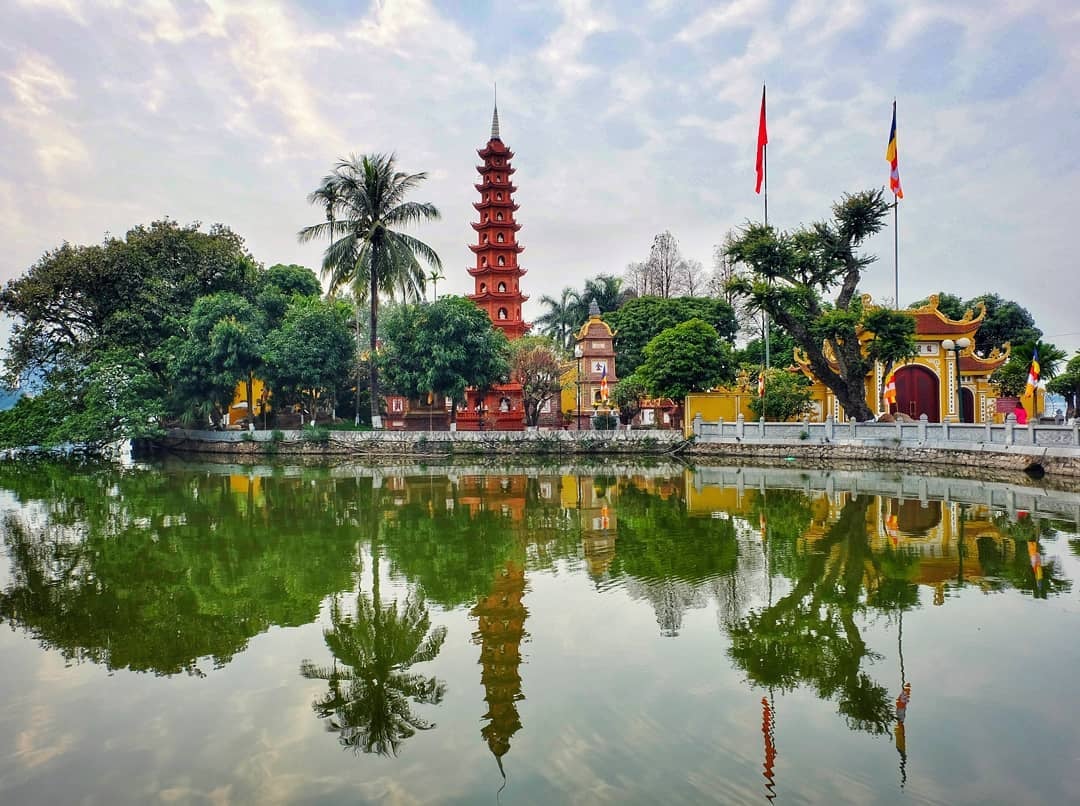
Tran Quoc Pagoda reflects shimmeringly in the middle of West Lake, Hanoi (Photo: Collected)
The capital Hanoi is still famous as a land with a rich culture, history and countless famous landscapes and sacred temples, pagodas and shrines. When traveling to Hanoi , visitors should take some time to visit Tran Quoc Pagoda – a 1500-year-old pagoda with architectural beauty and long-standing historical and spiritual values.
1. Who is Tran Quoc Pagoda worshiping?
If you are planning a spiritual trip to visit Hanoi’s pagodas , you cannot miss Tran Quoc Pagoda . Once the Buddhist center of Thang Long during the Ly – Tran dynasties, Tran Quoc Pagoda in West Lake has now become an attractive spiritual destination, attracting a large number of tourists to visit and worship every year.
Tran Quoc Pagoda follows the Northern Buddhist sect. Inside the temple, there are shrines to Amitabha Buddha, Sakyamuni Buddha, and Guanyin Bodhisattva. The temple also has an altar to Quan Binh, Quan Vu, Chu Thuong, Duc Ong, and their attendants.
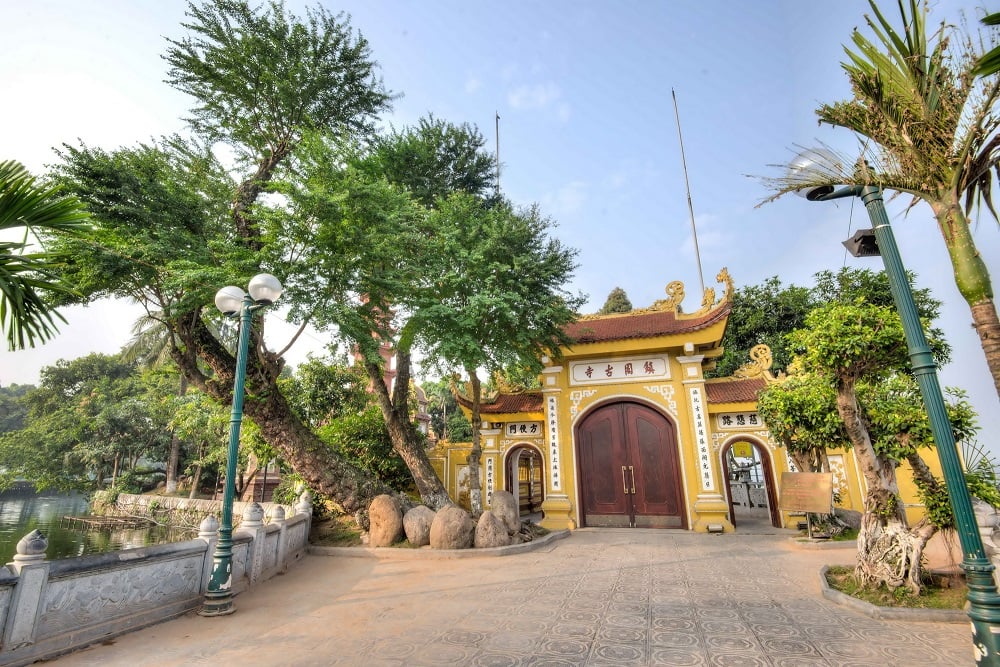
2. History of Tran Quoc Pagoda
According to historical records and documents, Tran Quoc Pagoda was built in 541 during the Early Ly Dynasty and was originally called Khai Quoc Pagoda . Initially, the pagoda was located on the land of Yen Hoa village, which is Yen Phu village today.
In 1440, King Le Thai Tong changed the name of the pagoda to An Quoc Pagoda with the wish for the country to be peaceful and long-lasting. In 1615, under the reign of King Le Kinh Tong, the pagoda was moved to the Yen Phu dike area, built on the old foundation of Han Nguyen Palace of the Tran Dynasty and Thuy Hoa Palace of the Ly Dynasty. In 1639, Lord Trinh built corridors on both sides and repaired the three-entrance gate. During the reign of King Le Hy Tong, the pagoda was renamed once again to Tran Quoc Pagoda. The pagoda had a bell cast, statues added and was restored in a very grand manner at the beginning of the Nguyen Dynasty. In 1821, King Minh Mang visited the pagoda and gave 20 taels of silver to expand and restore the pagoda. In 1842, King Thieu Tri gave 200 quan of money and 1 large gold coin and also changed the pagoda’s name to Tran Bac Pagoda . But people from ancient times still used to call the pagoda by the name Tran Quoc, thanks to which this name has been kept until today. Through many ups and downs, Tran Quoc Pagoda continues to be preserved, maintained and embellished by later generations to build the solemn beauty of this pagoda.
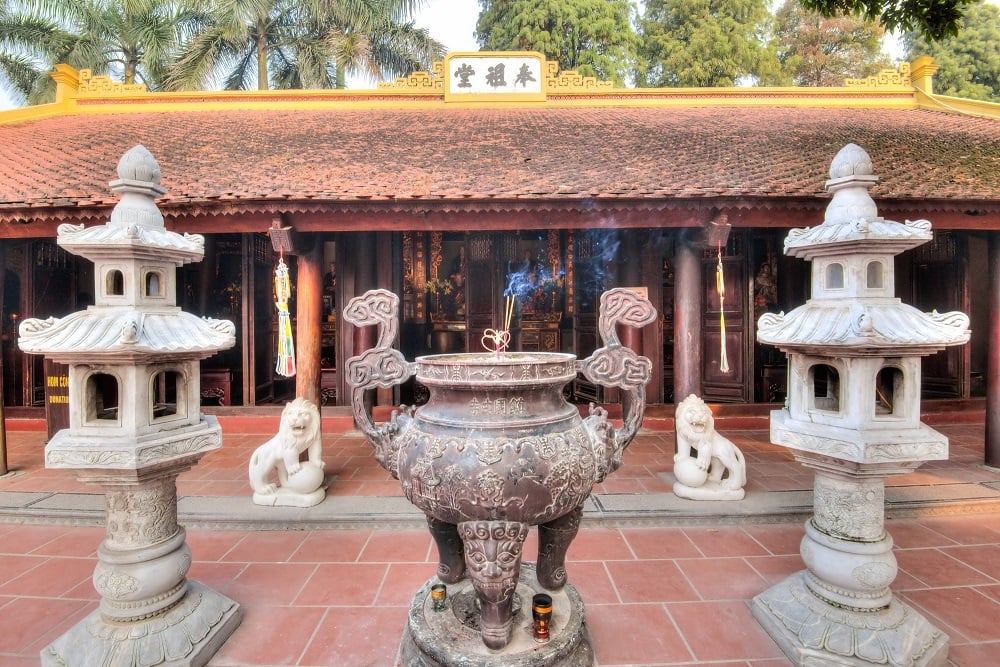
The official name of Tran Quoc Pagoda is Tran Bac Pagoda, however people are still more familiar with its previous name (Photo: Collected)
3. The value and meaning of Tran Quoc Pagoda
According to historical records, during the French colonial period, the Far East Institute conducted in-depth research and highly appreciated this ancient pagoda. In particular, Tran Quoc Pagoda is also ranked as one of the 10 historical works of Indochina. Through many historical changes, the pagoda has been protected, restored, and preserved its architectural and cultural beauty. In 1962, Tran Quoc Pagoda was recognized by the Ministry of Culture and Information as a National Historical and Cultural Relic. For Vietnamese Buddhism, Tran Quoc Pagoda is truly a source of pride, a valuable heritage possessing architectural, historical and cultural beauty. To this day, this work is still one of the sacred Buddhist places, a famous spiritual destination in Hanoi, attracting a large number of tourists and monks and Buddhists to worship.
4. Where is Tran Quoc Pagoda? How to get there?
Located on the island east of West Lake , Tran Quoc Pagoda is the most sacred ancient temple in Hanoi with an age of up to 1500 years. Tran Quoc Pagoda is located at 46 Thanh Nien Street, Yen Phu Ward, Tay Ho District, Hanoi .
Only about 4km from the city center, you can easily travel to Tran Quoc Pagoda by personal means such as motorbike, car or public means such as taxi, grab, bus. If traveling by bus, you can choose bus route 33 and route 50, both of which have stops very close to the pagoda.

Tran Quoc Pagoda is located at 46 Thanh Nien Street, Yen Phu Ward, Tay Ho District, Hanoi (Photo: Collected)
5. Opening hours and entrance fees to Tran Quoc Pagoda
Tran Quoc Pagoda opens to welcome visitors to visit and worship from 8am – 4pm every day . On the 1st and 15th of each month , the pagoda opens from 6am – 6pm and on New Year’s Eve, the pagoda is open all night.
Tran Quoc Pagoda does not charge entrance fees for both Hanoians and tourists. Therefore, you can freely visit, sightsee, and worship at the pagoda.
6. What is there to see at Tran Quoc Pagoda?
6.1. Explore the architecture of Tran Quoc Pagoda
The image of Tran Quoc Pagoda clearly shows the oriental motifs and natural landscapes arranged according to the strict principles and order of Buddhism. After many renovations and repairs, Tran Quoc Pagoda now has a total area of over 3000m2 including 3 main houses: Thieu Huong, Thuong Dien and Tien Duong connected together in the shape of the letter Cong.
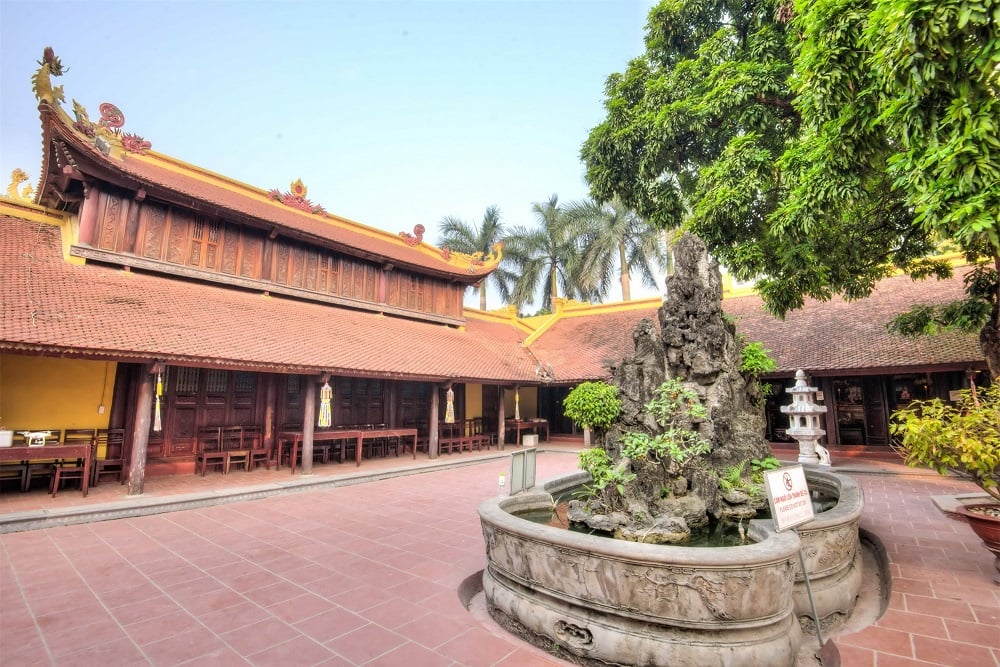
The peaceful and solemn scene inside Tran Quoc Pagoda (Photo: Collected)
The Front Hall is built to the west in the middle of the temple grounds. On both sides are the Incense Burner and the Upper Hall with two long corridors. Behind is a three-room house with a roof that overlaps the roof, followed by a bell tower on the main hall axis. On the left is the stele house preserving 14 steles of great cultural and historical value, and on the right is the ancestral house. In the 18th century, under the reign of King Le Y Tong, many more towers were built behind Tran Quoc Pagoda.
In 1998, the abbot of Tran Quoc Pagoda, Venerable Kim Cuong Tu, built the Luc Do Dai Sen Stupa, which stands out in the middle of the ancient tower garden. The stupa is placed symmetrically with the Bodhi tree – a gift from Indian President Rajendra Prasad in 1959 when he visited the capital. With its great historical value and unique architecture, in 1989, Tran Quoc Pagoda was honored to be recognized as a National Historical and Cultural Relic.

Behind Tran Quoc Pagoda, many stupas were built (Photo: Collected)
6.2. Offering incense to Buddha to pray for peace
Tran Quoc Pagoda is a sacred place for people to pray for luck and peace. Going to Tran Quoc Pagoda has long become a habit of Hanoians every time Tet comes or every 1st and 15th day of the month. No matter when you go sightseeing or go to the pagoda, you need to buy incense, prepare offerings and prepare prayers carefully and methodically in front of the altars in the pagoda to show your respect. Some popular prayers at the pagoda you can refer to: prayers for peace, prayers to Duc Ong, prayers to the Three Jewels…
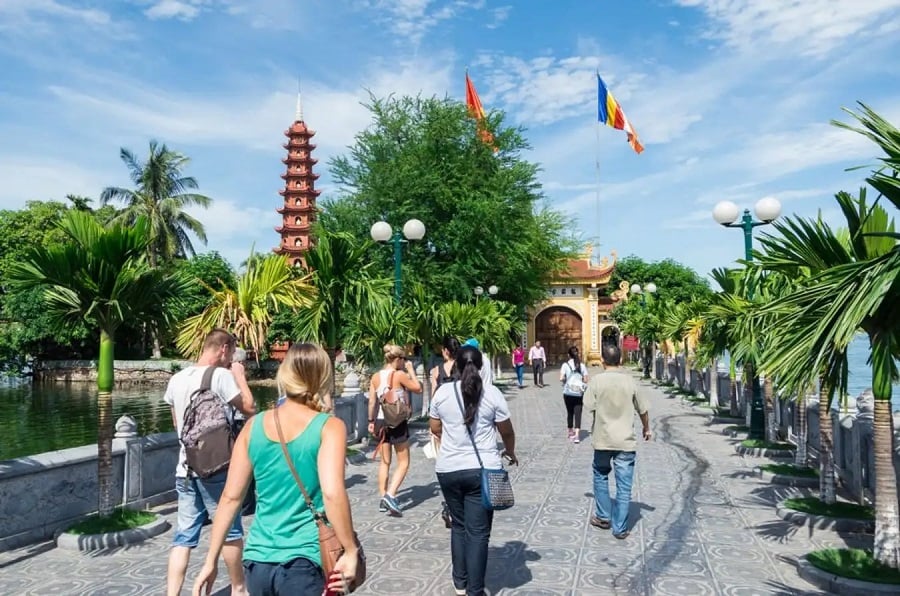
Tran Quoc Pagoda attracts many domestic and foreign tourists (Photo: Collected)
6.3. Admire the Bodhi tree at Tran Quoc Pagoda
Whenever mentioning Tran Quoc Pagoda, everyone will surely think of the large Bodhi tree grafted from the Great Bodhi Tree of Dao Trang. This is where Buddha Shakyamuni sat to practice 25 centuries ago. The Bodhi tree of Tran Quoc Pagoda also has many spiritual meanings. It is a symbol of compassion and altruism towards people and a symbol of Buddha’s wisdom. Every year, many tourists come to Tran Quoc Pagoda to worship and make a pilgrimage to pray to Buddha before this Bodhi tree.
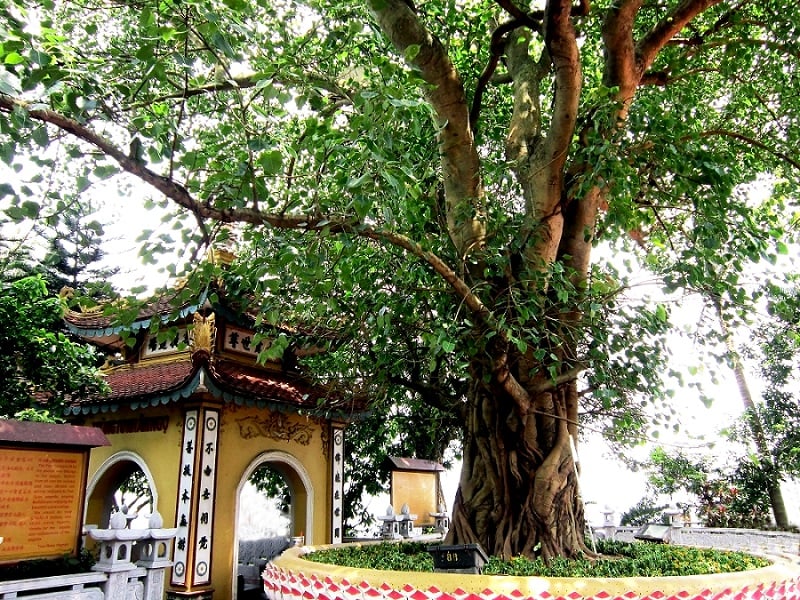
Admire the famous Bodhi tree at Tran Quoc Pagoda (Photo: Collected)
After nearly 60 years since Mr. Prasat donated it, the Bodhi tree has been carefully and meticulously cared for by the abbots of the temple to be as lush as it is today. The shade of the Bodhi tree makes the temple landscape poetic, peaceful and the air is also extremely fresh and cool.
6.4. Admire the unique beauty of Buddha and Bodhisattva statues
Visitors can admire the unique beauty of Buddha and Bodhisattva statues at the Tran Quoc Pagoda’s Stupa or the Front Hall. The 11-storey Stupa has an area of about 10.5 square metres. Inside the Stupa is a statue of Amitabha Buddha made of precious stones. There are about 66 other statues inside the tower. On top of the tower is a 9-storey lotus throne resembling a blooming lotus flower, exuding a fragrant scent, made of sparkling precious stones.

Bao Thap at Tran Quoc Pagoda (Photo: Collected)
After visiting the Bao Thap, visitors can go to pray to Buddha and make a pilgrimage to the Tien Duong house. Here, many mandarins and beautiful statues are worshiped. The most prominent is the statue of Buddha Sakyamuni entering Nirvana, painted with red and gilded gold. Other Buddha statues are cast in sparkling bronze.
7. What should you note when visiting Tran Quoc Pagoda?
Tran Quoc Tu is the most beautiful and sacred ancient pagoda in the capital. Therefore, the pagoda is always crowded with tourists and Buddhists coming to visit and worship. The 1st and 15th of the lunar month are the times when visitors to the pagoda are extremely crowded. In addition, the Lunar New Year is also the time when people gather at the pagoda to pray for good luck at the beginning of the year. Tourists can visit the pagoda at any time. However, to fully experience the peaceful beauty as well as to find peace and quiet at the Buddha’s door, you should visit the pagoda on weekdays.
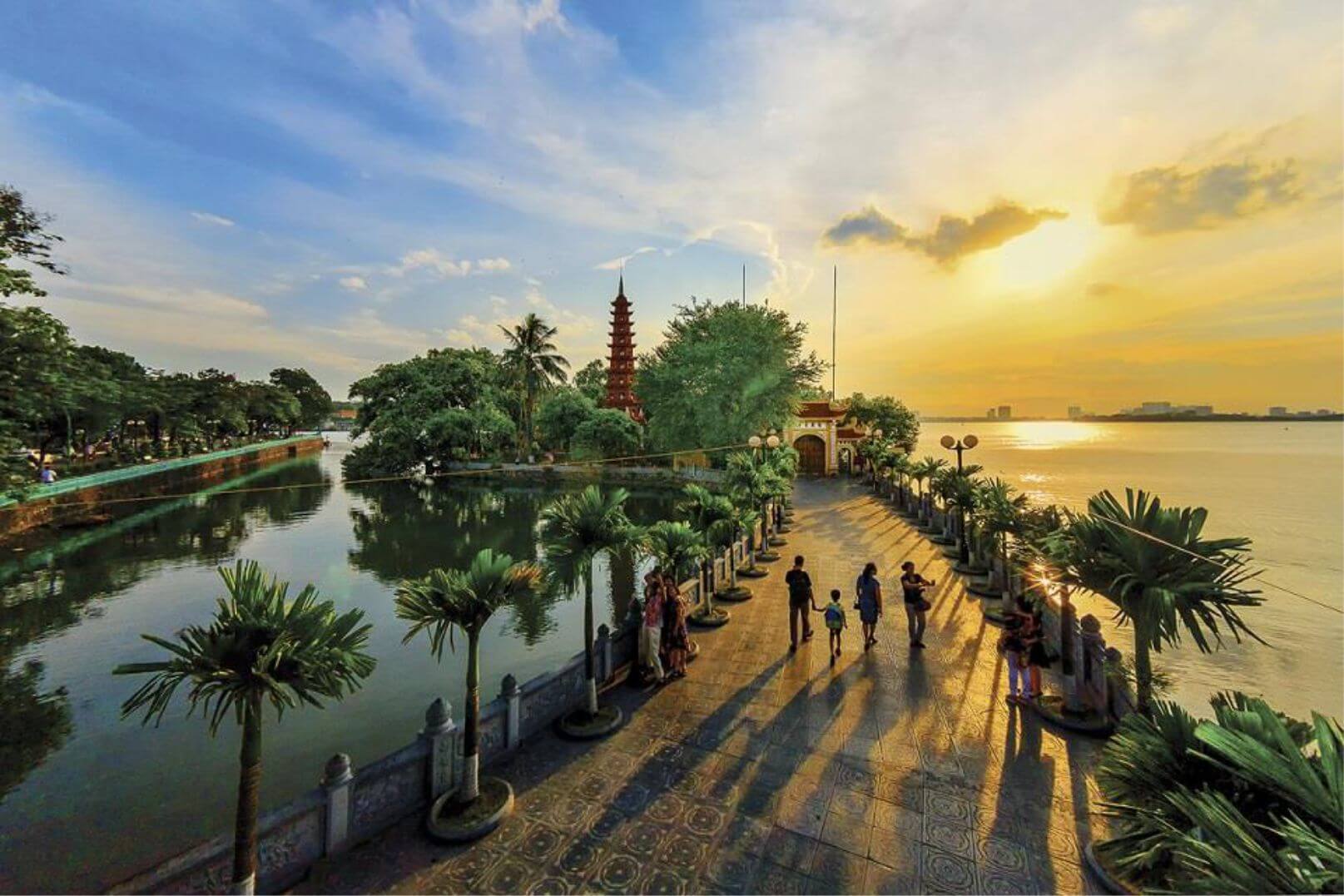
You should visit Tran Quoc Pagoda on weekdays to feel the peace and tranquility here (Photo: Collected)
The temple is a sacred place, so you need to choose polite, modest clothes, do not wear offensive or revealing clothes. Keep quiet, avoid making noise or having a rude attitude, ensuring solemnity when coming to the temple.
8. Famous tourist attractions near Tran Quoc Pagoda
To have more experiences during your trip to Hanoi, you should combine a visit to Tran Quoc Pagoda and nearby entertainment venues. Below is a list of famous destinations near the pagoda area that you can refer to:
8.1. Quan Thanh Temple
Spiritual tourism in Hanoi definitely cannot miss Quan Thanh Temple – one of the “four towns” of Thang Long Citadel. Through many time periods and many historical dynasties, Quan Thanh Temple still retains its unique cultural and architectural beauty, adding to the ancient color of the Capital.
8.2. Thang Long Imperial Citadel
Associated with the development of ancient Thang Long – Hanoi, Thang Long Imperial Citadel is one of the relic complexes that attracts a large number of tourists. In particular, in the historical relic system of Vietnam, Thang Long Imperial Citadel plays a very important role. Visitors to this place can visit prominent works such as: Doan Mon, Bac Mon, Dien Kinh Thien, archaeological site…
8.3. Ho Chi Minh Mausoleum
When traveling to Hanoi, you should definitely take the time to visit the Ho Chi Minh Mausoleum . This is where the body of the beloved leader of the nation is kept. Outside the mausoleum are planted rows of green bamboo, creating a peaceful, quiet scene. The mausoleum is open to visitors every Tuesday, Wednesday, Thursday, Saturday and Sunday morning. In addition to visiting, you can come to admire the raising and lowering of the flag at fixed times of the day. A small note when visiting the Ho Chi Minh Mausoleum is to dress neatly and not bring electronic recording devices.
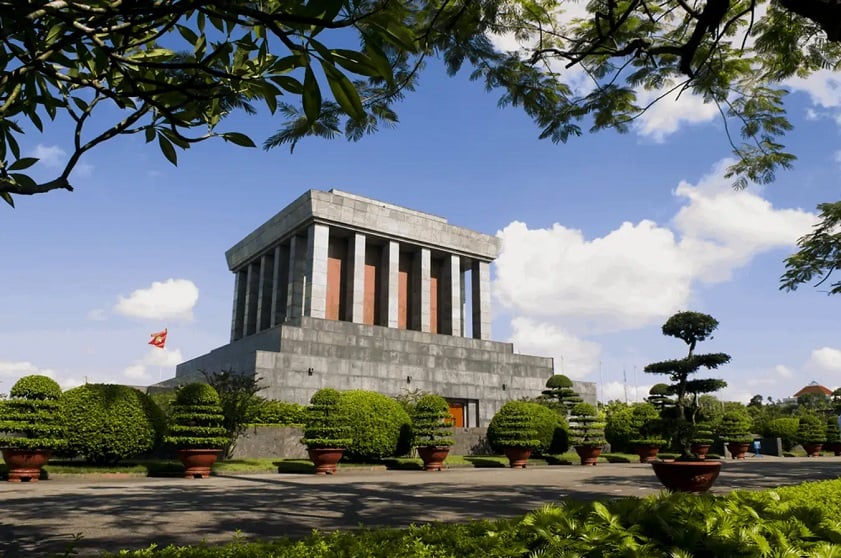
President Ho Chi Minh Mausoleum is one of the destinations near Tran Quoc Pagoda (Photo: Collected)
8.4. Hanoi Old Quarter
Walking around the old quarter, admiring ancient houses, and enjoying delicious specialties are experiences that you should not miss when traveling to Hanoi. Hanoi Old Quarter is located in the North and West of Hoan Kiem Lake. Each street sells a certain item, you can walk around to shop, take pictures… In addition, visitors should also take the time to enjoy the cuisine of the old quarter with some dishes such as: La Vong fish cake, Dinh Liet wonton noodles, Bat Dan pho…
8.5. Tay Ho Palace
Tay Ho Palace is also known as the temple of Princess Lieu Hanh. This is one of the famous spiritual tourist destinations of the capital. Tay Ho Palace has a unique architecture, every detail is meticulously carved, imbued with Vietnamese culture. Many people choose to come to Tay Ho Palace to sightsee, check in, and pray for health, fortune, career…
